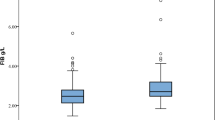Abstract
Vertigo is encountered frequently in emergency services. Researchers have explored the role of serologic markers in the differentiation of central and peripheral vertigo. The study reported here was designed to evaluate the diagnostic efficacy of serologic markers (fibrinogen, D-dimer, and C-reactive protein [CRP]) in the differential diagnosis of peripheral and central vertigo. A total of 116 patients who sought treatment for vertigo at Cazi University Hospital Adult Emergency Services during a 3-mo period were included in the study. CRP, fibrinogen, and D-dimer levels were assessed in an effort to differentiate between cases of peripheral and central vertigo. In all, 65.5% of patients (76 patients) were women. Patients younger than 50 y of age accounted for 60.3% (70 patients). The average D-dimer level for the entire group of patients was 1 81.9±132.2 μg/mL, the average CRP level, 4.2±8.4 mg/L, and the average fibrinogen level, 421.9±176.0 mg/dL. Although serum D-dimer, fibrinogen, and CRP values appeared to be higher in patients with central vertigo than in those with peripheral vertigo, no statistically significant differences were noted between the 2 groups in terms of these 3 parameters (P>.05). When 6 mg/L was used as the cutoff point for CRP and 320 mg/dL was used for fibrinogen, the numbers of patients with CRP and fibrinogen levels higher than these values were significantly higher for central vertigo than for peripheral vertigo (P<.05). The present study shows that blood D-dimer, fibrinogen, and CRP levels cannot be significant markers for the differentiation of central and peripheral vertigo.
Similar content being viewed by others
References
Goldman B. Vertigo and dizziness. In: Tintinally JE, Kelen DG, Stapczynski JS, eds.Emergency Medicine: A Comprehensive Study Guide. 5th ed. New York: McGraw-Hill; 2000:1452–1462.
Baloh RW. Approach to the patient with dizziness. In:Dizziness, Hearing Loss and Tinnitus. 1st ed. Philadelphia, Pa: FA Davis; 1998:55–65.
Hotson JR, Baloh RW. Acute vestibular syndrome.N Engl J Med. 1998;339:680–685.
Solomon D. Distinguishing and treating causes of central vertigo.Otolaryngol Clin North Am. 2000;33:579–601.
Delaney KA. Bedside diagnosis of vertigo: value of the history and neurological examination.Acad Emerg Med. 2003;10:1388–1395.
Gizzi M, Riley E, Molinari S. The diagnostic value of imaging the patient with dizziness.Arch Neurol. 1996;53:1299–1304.
Herr RD, Zun L, Mathews JJ. A directed approach to the dizzy patient.Ann Emerg Med. 1989; 18:664–672.
Fattori B, Nacci A, Ghilardi PL, Bruschini L, Matteucci F, Ursino F. Acute peripheral vertigo: involvement of the hemostatic system.Int Tinnitus J. 2003;9:124–129.
Fattori B, Ursino F, Cristofani R, et al. Relevance of plasma D-dimer measurement in patients with acute peripheral vertigo.J Laryngol Otol. 2003;117:467–472.
Fattori B, Nacci A, Casani A, et al. Hemostatic alterations in patients with acute, unilateral vestibular paresis.Otolaryngol Head Neck Surg. 2001;124:401–407.
Milionis HJ, Mittari V, Exarchakos G, et al. Lipoprotein (a) and acute-phase response in patients with vestibular neuronitis.Eur J Clin Invest. 2003;33:1045–1050.
Du Clos TW. Function of C-reactive protein.Ann Med. 2000;32:274–278.
Cook NS, Ubben D. Fibrinogen as a major risk factor in cardiovascular disease.Trends Pharmacol Sci. 1990;11:444–451.
Grau JA, Buuggle F, Becher H, et al. The association of leukocyte count, fibrinogen and C-reactive protein with vascular risk factors and ischemic vascular diseases.Thrombosis Res. 1996;82:245–255.
Rost NS, Wolf PA, Kase CS, et al. Plasma concentration of C-reactive protein and risk of ischemic stroke and transient ischemic attack (Framingham Study).Stroke. 2001;32:2575–2579.
Di Napoli M, Papa F, Bocola V. Prognostic influence of increased C-reactive protein and fibrinogen levels in ischemic stroke.Stroke. 2001;32:133–138.
Di Napoli M, Papa F. Inflammation, hemostatic markers and antithrombotic agents in relation to long-term risk of new cardiovascular events in first-ever ischemic stroke patients.Stroke. 2002;33:1763–1785.
Haapaniemi E, Soinne L, Syrjala M, et al. Serial changes in fibrinolysis and coagulation activation markers in acute and convalescent phase of ischemic stroke.Acta Neurol Scand. 2004;110: 242–247.
Kelly J, Rudd A, Lewis RR, et al. The relationship between acute ischaemic stroke and plasma D-dimer levels in patients developing neither venous thromboembolism nor major intercurrent illness.Blood Coagul Fibrinol. 2003;14:639–645.
Tohgi H, Konno S, Takahashi S, et al. Activated coagulation/fibrinolysis system and platelet function in acute thrombotic stroke patients with increased C-reactive protein levels.Thromb Res. 2000;100:373–379.
Muir WK, Weir CJ, Alwan W, et al. C-reactive protein and outcome after ischemic stroke.Stroke. 1999;30:981–985.
Beamer NB, Coull BM, Clark WM, et al. Persistent inflammatory response in stroke survivors.Neurology. 1998;50:1722–1728.
Author information
Authors and Affiliations
Corresponding author
Rights and permissions
About this article
Cite this article
Akinci, E., Aygencel, G., Keles, A. et al. Role of C-reactive protein, D-dimer, and fibrinogen levels in the differential diagnosis of central and peripheral vertigo. Adv Therapy 24, 1068–1077 (2007). https://doi.org/10.1007/BF02877713
Issue Date:
DOI: https://doi.org/10.1007/BF02877713




